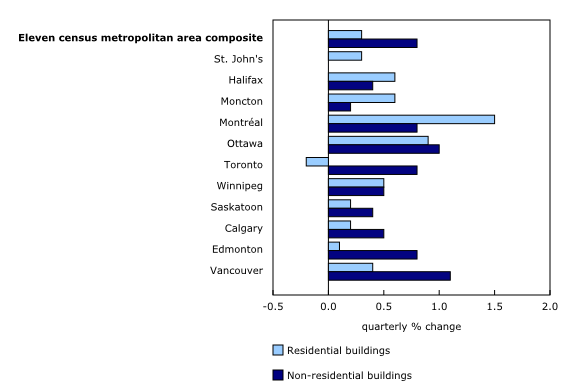Building construction price indexes, first quarter 2019
Archived Content
Information identified as archived is provided for reference, research or recordkeeping purposes. It is not subject to the Government of Canada Web Standards and has not been altered or updated since it was archived. Please "contact us" to request a format other than those available.
Released: 2019-05-16
As was the case during the last two quarters of 2018, prices for the construction of non-residential buildings increased more than construction prices for residential buildings in the first quarter of 2019.
The on-going US steel tariffs imposed in June 2018 still had some lingering impacts on the construction costs of both types of structures, according to some contractors surveyed. Although prices for steel and metal products are still high, they started to stabilize in the first quarter of 2019.
Non-residential buildings, quarterly change
Non-residential building construction costs increased 0.8% in the first quarter, following a 1.1% gain in the fourth quarter of 2018. Construction costs were up for all types of non-residential buildings in 10 of 11 census metropolitan areas (CMAs) surveyed.
Construction costs rose the most in Vancouver (+1.1%) and Ottawa (+1.0%). These increases were attributable to the continued rise in prices for metal fabrication and for concrete products. Higher prices for structural steel framing also pushed up construction costs for all of the non-residential building types surveyed.
Non-residential buildings, 12-month change
Prices for the construction of non-residential buildings were up 4.8% over the 12-month period ending in the first quarter, led by higher construction costs in Ottawa (+7.0%) and Vancouver (+6.0%).
Residential buildings, quarterly change
At the national level, construction costs for all types of residential buildings rose 0.3% in the first quarter, following a 0.5% increase in the previous quarter.
The CMAs of Montréal (+1.5%) and Ottawa (+0.9%) posted the largest increases. In Montréal, costs for the construction of townhouses and single-detached homes each increased 1.6%.
Among all the CMAs surveyed, Toronto posted the lone decrease (-0.2%) for the construction costs of all residential building types surveyed in the first quarter. This marked the second consecutive decline in this CMA as single-detached houses and townhouses (each down 0.3%) showed the largest decreases.
Residential buildings, 12-month change
Prices charged by contractors for residential building construction were up 3.6% over the 12-month period ending in the first quarter. On an annual basis, construction costs rose the most in Ottawa (+6.7%) and Vancouver (+4.4%).
Note to readers
The building construction price indexes (BCPI) are quarterly series that measure change over time in the prices that contractors charge to construct a range of new commercial, institutional, industrial and residential buildings in 11 census metropolitan areas: St. John's, Halifax, Moncton, Montréal, Ottawa–Gatineau (Ontario part), Toronto, Winnipeg, Saskatoon, Calgary, Edmonton and Vancouver.
These buildings include six non-residential structures: an office building; a warehouse; a shopping centre; a factory; a school; and a bus depot with maintenance and repair facilities. In addition, indexes are produced for five residential structures, including a bungalow, a two-storey house, a townhouse, a high rise apartment building (five storeys or more) and a low rise apartment building (less than five storeys).
The contractor's price reflects the value of all materials, labour, equipment, overhead and profit to construct a new building. It excludes value added taxes and any costs for land, land assembly, building design, land development and real estate fees.
With each release, data for the previous quarter may have been revised. The index is not seasonally adjusted.
Products
A video entitled "Producer Price Indexes" is available on the Statistics Canada Training Institute webpage. It provides an introduction to Statistics Canada's Producer Price Indexes — what they are, how they are made and what they are used for.
A Historical Timeline of Canadian Producer Price Statistics
"A Historical Timeline of Canadian Producer Price Statistics," which is part of the Prices Analytical Series (62F0014M), was created to showcase the key milestones in the history of Canadian producer price statistics. This historical timeline contains answers to questions such as: Who collected Canada's first statistics? What do Canadian producer price indexes measure?
Infographic: Producer Price Indexes at a Glance
The infographic "Producer Price Indexes at a Glance," which is part of Statistics Canada — Infographics (11-627-M) demonstrates how producer price indexes for goods and services are calculated and why they are important for the Canadian economy.
Contact information
For more information, or to enquire about the concepts, methods or data quality of this release, contact us (toll-free 1-800-263-1136; 514-283-8300; STATCAN.infostats-infostats.STATCAN@canada.ca) or Media Relations (613-951-4636; STATCAN.mediahotline-ligneinfomedias.STATCAN@canada.ca).
- Date modified:



